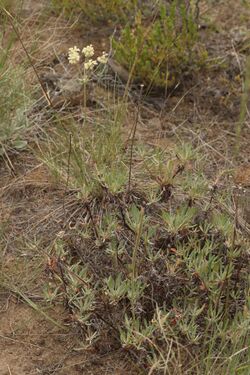Biology:Eriogonum heracleoides
| Eriogonum heracleoides | |
|---|---|

| |
| Scientific classification | |
| Kingdom: | Plantae |
| Clade: | Tracheophytes |
| Clade: | Angiosperms |
| Clade: | Eudicots |
| Order: | Caryophyllales |
| Family: | Polygonaceae |
| Genus: | Eriogonum |
| Species: | E. heracleoides
|
| Binomial name | |
| Eriogonum heracleoides Nutt.
| |
Eriogonum heracleoides (common names; parsnipflower buckwheat, whorled buckwheat, and Wyeth buckwheat[1]) is a plant of western North America that has many flowering clusters which are usually cream colored, or off-white. It can usually be found in rocky areas, such as sagebrush deserts and Ponderosa pine forests. Parsnipflower buckwheat is in the genus Eriogonum and the family Polygonaceae, which is a family of plants known as the "knotweed family". It inhabits much of the western part of the United States and southern British Columbia.[2][3]
Description
The parsnipflower buckwheat is an erect herbaceous perennial plant rarely more than 40 cm (15 3⁄4 in) tall. Blooming early in the summer, its flowers measure 4–9 mm (1⁄8–3⁄8 in); these are pale yellow and redden with age.[4] The leaves are arranged in loose rosettes, covered with soft hairs measuring 5–30 mm (1⁄4–1 1⁄8 in). The hairs feel woolly and matted, and cover both sides of the leaf.[5] The flowers have one carpel (achene). The plant has a whorled arrangement of leaves at midpoint of the stem[6][7] as well as one beneath the base of the stems.[4] It blooms in early to mid summer. It attracts butterflies, bees, insects, and birds and is the host plant for several Palouse butterflies.[8]
References
- ↑ United States Department of Agriculture Natural Resources Conservation Service. "Parsnipflower buckwheat". Plant Guide. http://plants.usda.gov/plantguide/pdf/pg_erhe2.pdf.
- ↑ Sullivan, Steven. K. (2020). "Eriogonum heracleoides". http://www.wildflowersearch.com/search?&PlantName=Eriogonum+heracleoides. Retrieved 2020-09-22.
- ↑ USDA, NRCS. (2020). "Eriogonum heracleoides". National Plant Data Team, Greensboro, NC 27401-4901 USA.. http://plants.usda.gov/java/profile?symbol=ERHE2. Retrieved 2020-09-22.
- ↑ 4.0 4.1 Taylor, Ronald J. (1994) (in en). Sagebrush Country: A Wildflower Sanctuary (rev. ed.). Missoula, MT: Mountain Press Pub. Co. pp. 28. ISBN 0-87842-280-3. OCLC 25708726. https://www.worldcat.org/oclc/25708726.
- ↑ Floras Flora in North America. "Parsnipflower buckwheat". http://www.efloras.org/florataxon.aspx?flora_id=1&taxon_id=250060323.
- ↑ Klinkenberg, Brian, ed (2020). "Eriogonum heracleoides". Lab for Advanced Spatial Analysis, Department of Geography, University of British Columbia, Vancouver. http://linnet.geog.ubc.ca/Atlas/Atlas.aspx?sciname=Eriogonum%20heracleoides. Retrieved 2020-09-22.
- ↑ Giblin, David, ed (2020). "Eriogonum heracleoides". Burke Museum, University of Washington. http://biology.burke.washington.edu/herbarium/imagecollection/taxon.php?Taxon=Eriogonum%20heracleoides. Retrieved 2020-09-22.
- ↑ Thorn Creek Thorn Creek Native Seed. "Wyeth buckwheat". http://www.nativeseedfarm.com/details.php?id=17.
Further reading
- Daniel E. Moerman (2009). "Eriogonum heracleoides". Native American Medicinal Plants: an ethnobotanical dictionary. Portland, OR / London: Timber Press. pp. 194. ISBN 978-0-88192-987-4.
External links
Wikidata ☰ Q5389387 entry
 |

